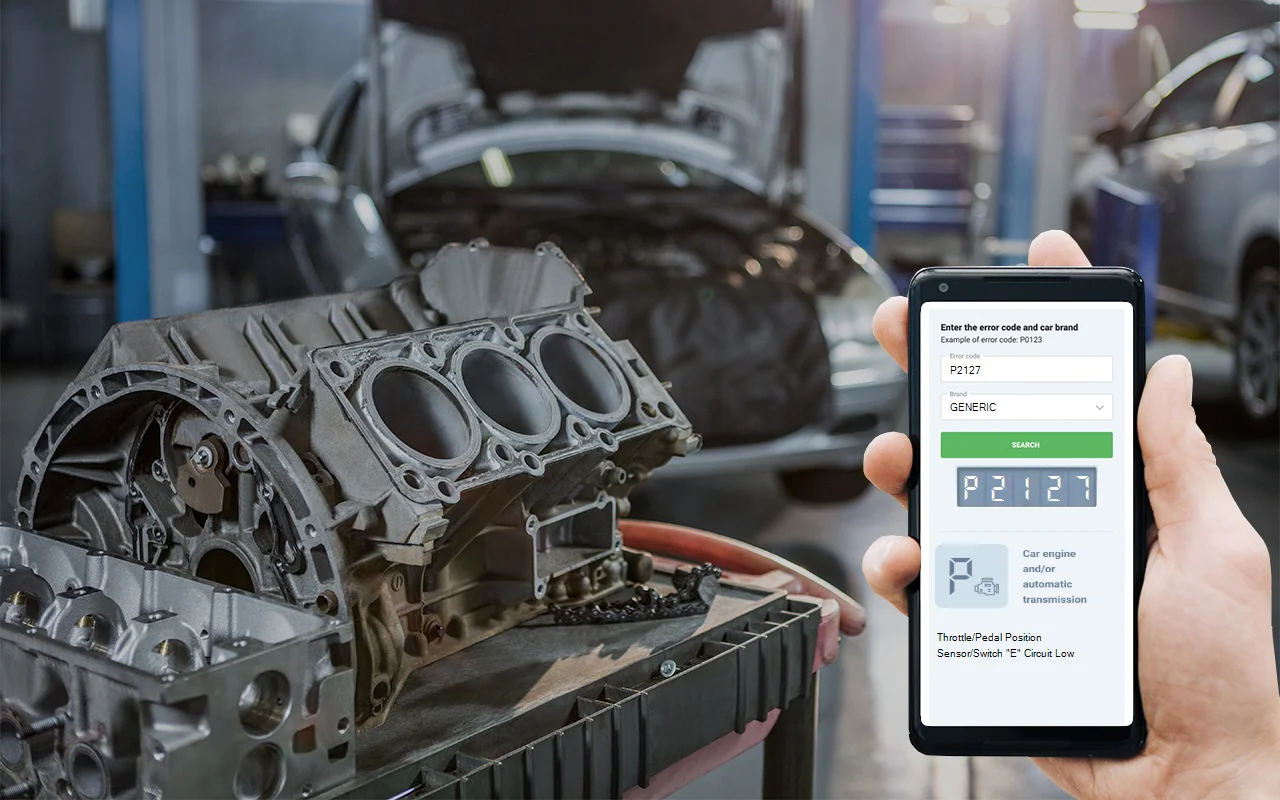When you see a P2127 code pop up, that’s your car’s PCM (powertrain control module) telling you it’s not happy with the voltage reading it’s getting from the throttle or accelerator pedal position sensor-specifically from what’s known as the “E” circuit. This sensor is vital to your electronic throttle control setup. Every time you press the gas pedal, that sensor’s job is to relay your intentions straight to the engine. If the PCM notices that the voltage is lower than it should be, it throws this code. Now, depending on what you’re driving, the wiring or the sensor layout might change a bit, but the core issue stays the same: the message between your foot and your engine isn’t clear. And when that happens? The car may step in to protect itself by cutting power and putting you into what we call ‘limp mode.’
DTC P2127
Causes of P2127 Code
From my time under the hood, the biggest culprits behind a p2127 code are almost always the accelerator pedal position assembly or the wiring that ties everything together. Let me break down what typically causes this headache:
- Accelerator pedal position assembly failure-sometimes it’s just the sensor, but I’ve seen the whole pedal unit fail too
- Wiring gremlins: shorts to ground, cracked insulation, or connectors working themselves loose
- A throttle position sensor (TPS) that’s not secure or is acting up
- Throttle control motor biting the dust
- PCM failure-rare, but I’ve seen it once or twice
Most times, you’re looking at a wiring or sensor issue, but I don’t rule out anything until I’ve checked it myself. I’ve seen this pop up on Fords, Dodges, Nissans-you name it. No brand’s immune.
Symptoms of OBD2 Code P2127
If you’re staring down obd2 code P2127, there are a few telltale signs. Here’s what most folks notice in the shop:
- Check engine light glaring at you
- Idling that’s rough or all over the place
- Stalling or hesitation-especially when pulling away from a stop
- Engine surging or behaving unpredictably
- Acceleration that feels like you’re dragging an anchor
- Overall sluggish performance
- The dreaded ‘limp mode,’ where your power gets chopped
In my shop, limp mode and a dead throttle pedal are the most common complaints. Can’t say I blame anyone for being annoyed by that.

Diagnosis Steps for OBD Code P2127
When it comes to diagnosing obd code P2127, I always start with the basics and work up from there-no sense chasing ghosts. Here’s my usual approach:
- Start by scanning for any other codes. Sometimes, there’s a bigger story hiding in those extra codes.
- Next, I get my eyes on all the wiring and connectors at the accelerator pedal and throttle body. Frayed wires, green corrosion, or loose plugs-these are classic troublemakers. I’ll have a helper press the pedal while I look for anything twitchy in the wiring.
- Then it’s time for the multimeter. I measure the voltage at the pedal position sensor, focusing on the ‘E’ circuit. Factory specs tell you what you should see-if it’s too low, you’ve found a suspect.
- If wiring and voltage look solid, I check the sensor itself. Swapping in a known-good part is a quick way to confirm if the original’s toast.
- If all else fails, I’ll dig into the throttle body and control motor, and as a last resort, the PCM.
Pro-tip: don’t skip checking if the sensor’s mounted tight. A loose bracket can throw off readings and waste hours of your time. Always nail down the basics before throwing parts at the problem.

Common Mistakes with P2127 Trouble Code
One mistake I see over and over? Folks shelling out for a new pedal or throttle body without even glancing at the wiring. That’s a fast track to spending money you didn’t need to. Another blunder is overlooking a crusty or loose connector-these little things cause big headaches. And skipping the voltage check? That’s just asking for a wild goose chase. Always pin down the real issue before you start swapping parts.

Seriousness of P2127 Engine Code
Ignore P2127 at your own risk. When this code’s active, your car can suddenly lose power or drop into limp mode without warning. That’s a big deal-especially if you’re in the middle of traffic or trying to merge onto a busy highway. If you let it slide, you could end up stalled somewhere unsafe. Plus, lingering electrical problems can take out your PCM or throttle control motor if you’re not careful. My advice? Don’t wait on this one.
How to Repair DTC P2127
Once I’ve chased down what’s causing dtc P2127, here’s how I tackle the fix:
- Patch up or replace any damaged wires or crusty connectors in the throttle or pedal position circuit
- If the accelerator pedal position sensor or the whole assembly is toast, swap it out
- Make sure the throttle position sensor’s snug and secure-loose sensors make for wild readings
- If the throttle control motor’s acting up, it gets replaced
- In those rare cases where the PCM is at fault, reprogramming or replacement is needed
Start with the cheap and simple stuff-like wiring repairs-before you start replacing sensors or computers. I use the same approach whether it’s a Dodge or a Nissan with this problem. No shortcuts here.
Conclusion
Bottom line? P2127 means your engine isn’t getting the message from your gas pedal, usually thanks to a wiring or sensor hiccup. This can mess up how your car drives and put you in a risky spot if limp mode kicks in or the engine stalls. My advice: get on this quick. Start by giving the wiring and connectors a good look. Nine times out of ten, fixing a bad wire or swapping out the pedal sensor gets you back on the road. Don’t put it off-your safety and your car’s reliability depend on it.




